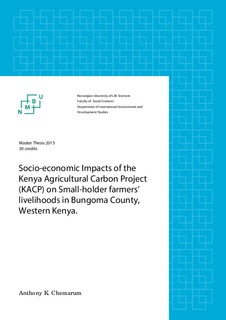| dc.description.abstract | Agricultural carbon sequestration projects have been embraced in the recent past seeking to demonstrate how agricultural carbon finance may function to reduce emissions and at the same time generate improved local livelihoods. However, the initiatives have not achieved readily tangible social, economic and environmental impacts. The Kenya Agricultural Carbon Project (KACP) is one flagship initiative in Western Kenya, East Africa. It has aimed at reducing poverty levels of small-holder farmers in Western Kenya by promoting sustainable agricultural land practices to boost their farm yields and increase food security while still generating carbon sequestration and subsequent revenue. This study sought to look into KACPs livelihood consequences/outcomes on the target populations. The study makes an overall assessment of the socio-economic adaptation of households, the impacts of KACP on the livelihoods of poor small-scale farmers and also assessing farmers’ understanding of the carbon financing and marketing concepts. It employs a mixed methods approach using household questionnaires, focus group discussions and key informant interviews. Descriptive and analytical models are used to test for significant associations and differences.
The study finds that farmers in Western Kenya are generally both asset-poor and poor in terms of cash and subsistence incomes. The project areas further lack access to developed physical infrastructure especially access to electricity and good road networks and well-functioning markets. Most livelihood activities in the project area are on-farm-oriented (50%) compared to off-farm (18%) and non-farm (32%) activities. On-farm activities feature food crops farming, cash crop farming and livestock keeping while off-farm and non-farm activities feature tradable manual employment and income-generating rural services. Poor people adapt through higher incomes from off-farm and on-farm activities while the wealthier adapt more through non-farm incomes. Looking at variation by location, we do find that areas with more land and better market access (Malakisi division) report wider asset portfolios, higher asset levels and have higher income levels (70% of total income). Concerning adoption of carbon sequestration measures (SALM) generally, it appears farmers achieve quite high adoption rates (on average 54%). There is also variation between measures among groups (ranging from 20%-90%) depending upon their suitability, their labour and financial costs of SALM implementation and farmers general willingness to adopt more or less technically advanced practices. The more asset-rich and wealthy group tend to adopt more (70% versus around 45%) as does people from locations with higher asset access and better market infrastructure.
The study indicates that KACP farmers were lacking a broader understanding of the interrelationship between soil carbon emissions, SALMs implementation and global climate change. Still, they appreciate the practical economic value of carbon revenue earning through tree planting. The study findings reveal that the annual mean carbon revenue per farmer per year (only Kshs. 216; some USD2/farmer and year) forms no incentive or economic advantage for SALMs adoption (a miniscule 0.17% of total household income). It was however understood and maybe also accepted by many farmers as a symbol of appreciation for their SALM implementation efforts.
So, the project does bring some benefits and incomes to local people. However, this is not because of its carbon sequestration and PES design qualities. The KACP markets itself as a carbon sequestration project but in reality this is not the case. The project is rather undertaken within a traditional ecological or conservation farming frame and as such, the KACP institutionalization legitimizes practice rather than its presupposed transformative orientation. | nb_NO |

